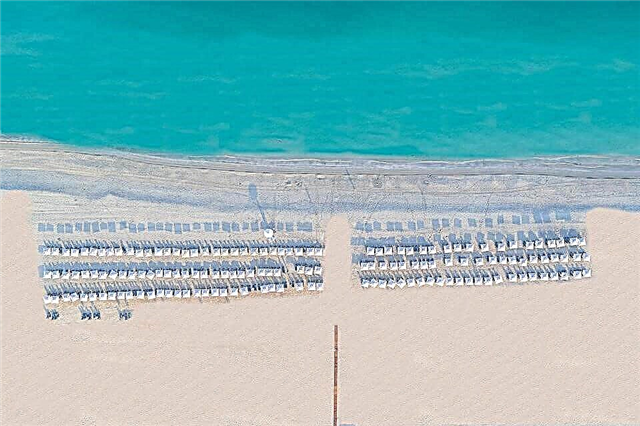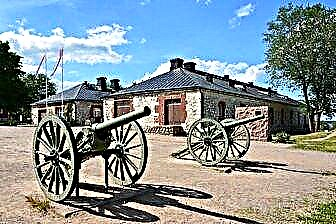Address: Russia, Pskov region, Pskov district, Elizarovo
Foundation date: 1447 year
Main attractions: Cathedral of Three Saints, the Church of Gabriel the Archangel in the hegumen's house
Shrines: Constantinople icon of the Mother of God, Savior-Almighty Eleazarovsky
Coordinates: 58 ° 03'00.5 "N 28 ° 11'31.8" E
Cultural heritage site of the Russian Federation
Content:
Each monastery has its own dedication. The ancient monastery in the village of Elizarovo, Pskov region, is no exception. In former times it was called the Three Saints, because they founded an Orthodox monastery in honor of the great Cappadocians - John Chrysostom, Gregory the Theologian and Basil the Great. Today it is a functioning nunnery that attracts not only pilgrims. Many lovers of Russian history and temple architecture come here.

Holy gates
How the monastery was founded
The first in the place where the monastery now stands were the sisters of the Pskov Ioannovsky monastery, which was located in Pskov. However, it was difficult for women to develop the forest wasteland located near Lake Peipsi, and soon the community left it.
Time passed, and in 1425 the 29-year-old monk of the Snetogorsk monastery Euphrosynus found himself here. He was born in the village of Videlibye in the Pskov region and before taking monastic vows bore the name Eleazar. It is known that the monk was well educated, was considered a great lover of books and a theologian. As a monk, Euphrosynus made a pilgrimage trip to Constantinople and met the Patriarch there.
At first, the monk lived alone in the forest, but gradually other hermits gathered around him. The place where they settled was removed from the people. Homemade wooden cells stood under the hill, between the two branches of the Tolba River. And although everyone wanted to build a monastery here, there was not much room for the erection of temples and other buildings in the river floodplain.

View of the monastery from the road 58K-96
According to the surviving tradition, Euphrosynus had a dream in which three saints appeared before him. They gave the elder advice - to dig the hill and cover one of the Tolba's branches with earth. Euphrosynus told the monks about the miraculous vision, and they acted on the advice of the saints. Thanks to the monks and peasants, a cathedral and new monastic cells appeared on the site formed.
In the history of the church, Euphrosynus is revered as an ascetic and mentor. He became a teacher for many monks who, leaving the walls of their native monastery, founded 10 other monasteries in the Pskov lands. It is curious that many of his disciples were later canonized by the church.
Euphrosynus himself was distinguished by great modesty and preferred to lead a solitary life. Therefore, even when the monastery was founded, he did not take on the duties of its abbot and did not accept the dignity of a priest. The first to lead the brethren was hegumen Ignatius.

View of the monastery from the side of the pond
Shortly before his death, Euphrosynus accepted the schema under his worldly name Eleazar. The elder died in 1491 at the age of 95, and was buried in the Cathedral of the Three Saints. According to the will of Euphrosynus, all the property that belonged was divided between the brethren, and in memory of the founder, the monastery began to be called Eleazarovsky.
The history of the monastery from the 16th century to the present day
The Pskov-Pechersk monastery advocated the preservation of the independence of Pskov from the Moscow princes. The Eleazar Monastery, on the contrary, called for the rallying of the disparate lands under the leadership of Moscow. At the beginning of the 16th century, Elder Philotheus lived in the monastery. Almost no information about this monk has survived, with the exception of his letters addressed to the Grand Duke of Moscow Vasily III. The monk wrote several letters, and in one of them he said that two Roman empires were destroyed, Moscow is the third Rome, and “there will not be a fourth”.
In his letters, Philotheus called Basil III "the Orthodox Tsar" and urged not to violate the commandments laid down by his great predecessors - Emperor Constantine, Saints Vladimir and Yaroslav the Wise. This concept was taken up by the Grand Duke and formed the basis of Russian statehood. The interpretation "Moscow - the third Rome" became widespread, and starting with John III, all Moscow sovereigns were considered the successors of the emperors of Rome and Byzantium.

Cathedral of Three Saints. View of the south facade of the cathedral
The monks of the Eleazar Monastery were engaged in the creation of handwritten books. The monks who lived here compiled the life of the founder of the monastery - Elder Euphrosynus, edited the second Pskov chronicle, and also copied the old copy of the Lay of Igor's Host. It was this manuscript that was discovered at the end of the 18th century by the famous collector of antiquities - Count Alexei Musin-Pushkin.
The border position negatively affected the monastery. It was repeatedly plundered by Lithuanians, Poles and Livonian knights who attacked the Russian lands. By the middle of the 18th century, the role of the Eleazarov monastery diminished. Monks from several abolished monasteries by the order of Catherine II were transferred to it, and the monastery received the status of a second-class monastery.
At the beginning of the 20th century, daily services were held here, and there was an almshouse that supported the elderly and the disabled. The monastery lived according to the hostel charter. The monks tried to adhere to an ascetic lifestyle, following the example of the founder of the monastery, Elder Euphrosynus. Inhabitants performed all household work, and also worked in carpentry, tailor and shoe shops.

First Nursing Corps
In 1918, the new authorities closed the monastery, and the monks were sent on carts in the direction of Petrograd. According to the surviving documents, all the monks were shot. Until 1920, the life of the monastery church was supported by the efforts of several believers, while several times visiting commissions took out church valuables from it.
Then an institute was organized on the territory of the monastery, however, the professors and students soon moved to St. Petersburg. For a long time, in the former monastery there were alternately located experimental agricultural production, the People's House, an educational institution for mentally retarded children, a sanatorium for patients with tuberculosis and a recreation center. Then there was a children's camp and living quarters.
By 1999, from the old monastery buildings, only the old Three-Saints Cathedral with a destroyed bell tower and a building for the brethren, built at the beginning of the last century, were preserved. A year after the transfer of the territory of the convent, the first church service was held here. And then, for several years, Pskov restorers restored churches and buildings.

Chapel of the Savior Image Not Made by Hands
What can be seen in the monastery today
Today the monastery has been beautifully restored. The main thing in it is the majestic Cathedral of the Three Saints. The first stone temple appeared on this site in 1447, and then it was rebuilt many times. Today it is a three-apse one-domed church with a small bell tower above the stairs. It has 7 bells cast by Voronezh craftsmen.
In the snow-white hegumen's house there is a small temple of the Archangel Gabriel. Near the road there is a recently built beautiful chapel of the Savior Image Not Made by Hands. And in the building, which is occupied by the pilgrimage center, has created its own house church. In addition, there are two nursing buildings and outbuildings in the walled monastery territory.
Shrines of the Spaso-Eleazar monastery
As in many monasteries in Russia, ancient icons revered by believers are kept in the monastery near Pskov. One of them, the Tsaregrad Icon of the Mother of God, appeared in Constantinople in the middle of the 11th century, and later ended up in the Spaso-Eleazarovsky Monastery.

Tomb of Mother Superior Hegumina Elisabeth
The Livonian knights who plundered the monastery took the shrine with them.It is believed that the icon drowned in Lake Peipsi. Soon after that, a copy of this icon appeared in the monastery, which has survived to this day. The icon is written on a cedar board in ancient Greek script. It depicts the Mother of God with her son, and a dove can be seen in the hands of Jesus.
Another shrine of the Orthodox monastery is the icon of the Savior of Eleazarovsky, which is considered a masterpiece of ancient Russian art. She appeared in 1352 and was revered as miraculous. In the XIV century, they walked around Pskov with this icon, and according to legend, the crowded procession of the cross stopped the pestilence epidemic.
The icon-painting image came to the monastery in 1766. In the 20th century, it ended up in Moscow for restoration and was returned to the Pskov region only in 2010. Nowadays, the icon is dressed in a special icon case, equipped with an alarm and kept under constant temperature and humidity conditions.

Bilo
Monastery visit mode
Today the Spaso-Eleazarovsky Monastery is a functioning Orthodox women's monastery. Church services are held daily in the monastery churches. A monastic community, ruled by the abbess, lives here. The monastery is open for visits from morning to evening, however, tourists are not allowed to enter some buildings. In addition, all guests are requested not to photograph the nuns and novices.
How to get there
The monastery is located in the village of Elizarovo, 29 km north of Pskov. By car, you can drive up to it along the 58K-96 highway leading to Gdov. Within the city blocks of Pskov, this is Leon Pozemsky Street. The monastery territory is located to the west of the road, on the left bank of the Tolba River.

Church shop
Buses from Pskov to Gdov, Verkholino, Samolva, Seredka and Znamenka reach Elizarovo in 30-40 minutes. They leave from the city bus station, which is located next to the railway station "Pskov-1" ("Pskov-Passenger"). In addition, you can get to the monastery from Pskov by taxi.











